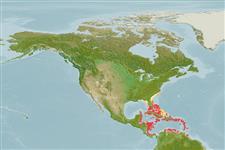Common names from other countries
>
Eupercaria/misc (Various families in series Eupercaria) >
Scaridae (Parrotfishes) > Sparisomatinae
Etymology: Sparisoma: Latin, sparus = a fish with a golden head + Greek, soma = body (Ref. 45335).
More on author: Valenciennes.
Environment: milieu / climate zone / depth range / distribution range
экология
морской ассоциированный с рифами; пределы глубины 1 - 15 m (Ref. 9710). Tropical; 42°N - 7°N, 88°W - 59°W (Ref. 88982)
Western Atlantic and the Caribbean. Confused with Southwest Atlantic specimens referring to Sparisoma axillare and Eastern Atlantic species referring to S. chaoti (Ref. 88982).
Length at first maturity / Size / Вес / Возраст
Maturity: Lm ?, range 16 - ? cm
Max length : 47.8 cm TL самец/пол неопределен; (Ref. 13628)
колючие лучи спинного плавника (общее число) : 9; членистые (мягкие) лучи спинного плавника (общее число) : 10; колючие лучи анального плавника: 3; членистые (мягкие) лучи анального плавника: 9. Juveniles and adults in drab phase (which are either mature males or females) are light grayish brown, nearly white ventrally; alternate dark and pale bars cross the chin; caudal peduncle and fin yellow; anal and pelvic fins red. Terminal phase males are dull green or blue-green with a large black spot on upper half of pectoral fin base; pectoral fins dark olive, the outer fifth abruptly pale (Ref. 13442).
Inhabits coral reefs and seagrass beds. Juveniles or primary-phase fish can rapidly assume a mottled pattern as it comes to rest on the bottom. Spawning is usually a group activity in similarly colored males and females (Ref. 5521). A protogynous hermaphrodite (Ref. 55367).
Life cycle and mating behavior
Maturities | размножение | Spawnings | Egg(s) | Fecundities | личинки
Although protogyny was propossed for this species (Ref. 27876), probably because testicular characteristics showed a secondary characteristic of sex-changed males, observations of overlapping size ranges of males and females, and males maturing at the same ages and sizes as did females, strongly suggest gonochorism (Ref. 103751). A monandric species (Ref. 55367). Length at sex change = 25.0 cm TL (Ref. 55367). Forms leks during breeding (Ref. 55367).
Lieske, E. and R. Myers, 1994. Collins Pocket Guide. Coral reef fishes. Indo-Pacific & Caribbean including the Red Sea. Haper Collins Publishers, 400 p. (Ref. 9710)
Статус Красного Списка МСОП (Ref. 130435)
CITES (Ref. 128078)
Not Evaluated
Угроза для людей
Reports of ciguatera poisoning (Ref. 30303)
Использование человеком
рыболовство: не имеет хозяйственного значения; аквариум: коммерческий
дополнительная информация
инструменты
Специальные отчеты
Скачать в формате XML
ресурсы в Интернет
Estimates based on models
Preferred temperature (Ref.
115969): 23.9 - 28.2, mean 27.5 (based on 467 cells).
Phylogenetic diversity index (Ref.
82804): PD
50 = 0.5000 [Uniqueness, from 0.5 = low to 2.0 = high].
Bayesian length-weight: a=0.00912 (0.00543 - 0.01532), b=3.05 (2.91 - 3.19), in cm Total Length, based on LWR estimates for this species & Genus-body shape (Ref.
93245).
Trophic level (Ref.
69278): 2.0 ±0.0 se; based on diet studies.
устойчивость к внешним воздействиям (Ref.
120179): высокий, минимальное время удвоения популяции до 15 месяцев (K=0.5).
Fishing Vulnerability (Ref.
59153): Low to moderate vulnerability (26 of 100).
